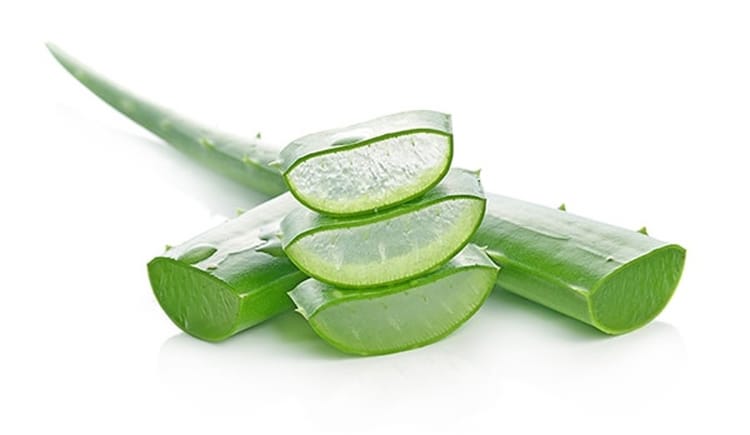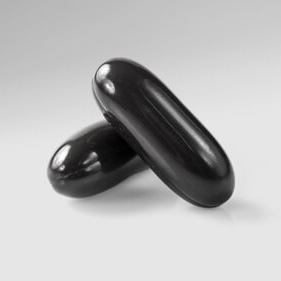BACKGROUND
Ingredient Type: Botanical
Also Known As: Aloe barbadensis, Aloe, Burn plant

Although aloe has been known and used for centuries throughout many different cultures, its medicinal uses are not outdated. From its anti-aging benefits when applied to the skin since the times of Nefertiti and Cleopatra (1), to its effects on the immune system when taken by mouth in more modern times, aloe has shown just how useful it can be. Aloe contains vitamins, minerals, enzymes, sugars, and fatty acids, just to name a few of the components in this plant (6).
Aloe vera was first discovered in Egypt, where it was considered the “Plant of Immortality.” It was used as an offering in burials of pharaohs dating as far back as 6000 years ago. It has been described in cultures throughout world history and has been used medicinally to treat wounded soldiers, taken internally as an elixir, and to soothe internal and external irritations. No wonder it has received such praise throughout ancient times, acquiring descriptive names such as “Nature Healer,” “Miracle Plant,” and “Silent Healer” (1).
TRADITIONAL USES
The medicinal uses of aloe span across the world and throughout history. It was used as a topical wound treatment by Alexander the Great and for embalming, beauty care, and medical treatments in ancient Egypt. The medicinal uses of aloe were discovered on ancient Sumerian clay tablets dating back to 2100 BC and was even mentioned as a laxative treatment in the Egyptian Papyrus Ebers from 1552 BC (3). Many of these medicinal uses have remained consistent throughout history and into modern times.
WHAT DOES SCIENCE TELL US?
Aloe Vera Probably Supports Cutaneous Wound Healing:
Several studies have been done to determine the usefulness of Aloe vera in cutaneous wound healing. Aloe vera gel contains glucomannan, which improves collagen production and secretion and accelerates wound improvement when applied topically (4). In one study, two different dressings were administered to 18 patients suffering from acne vulgaris, one dressing contained Aloe vera gel and polyethylene oxide gel, and one dressing contained only polyethylene oxide gel. One dressing with either gel was placed on each side of the face. After 48 hours, the side containing Aloe vera displayed vasoconstriction and a reduction in swelling. By the fourth day, the side treated with Aloe vera showed less crusting, and by the fifth day, the side treated with Aloe vera had 90% restorative function of the skin compared to 40-50% restorative function of the skin on the side not treated with Aloe vera. The conclusions of this study determined that the side treated with Aloe vera had an increase in wound healing about 72 hours faster than the side containing only polyethylene oxide gel (7).
Furthermore, the mucilage found within the Aloe vera gel contains other vitamins and nutrients such as vitamin E, vitamin C, and certain amino acids that aid in the acceleration of wound healing due to potent antioxidant effects (4). Antioxidants are substances that reduce and stop damage to cells. It has also been reported that Aloe vera may be protective in radiation damage to the skin. This may be due to an antioxidant called metallothionein, which is created inside of the skin; however, this exact mechanism is not known (4).
In another meta-analysis, Aloe vera was shown to be more effective than petroleum jelly gauze dressing, silver sulfadiazine 1% ointment, and framycetin cream for the healing of wounds. Aloe vera was shown to reduce redness, lessen itching, prevent infection, and decrease wound recovery time. Aloe vera was shown to be effective in decreasing the healing time for first and second-degree burns (11).
Aloe Vera Might Support Oral Health:
A study assessed the use of Aloe vera gel when used for in the treatment of periodontitis, which is an infectious and inflammatory oral disease. Inflammation refers to the body’s response to injury, leading to swelling and redness. This study tracked 15 patients and measured plaque, gum, and pocket depth indices at 1 and 3 months. All of these measures showed significant improvement, supporting the statement that Aloe vera can be beneficial for periodontal disease (16).
Furthermore, multiple studies have been conducted on the use of Aloe vera gel in the treatment of oral lichen planus. In two double-blind studies, responses in wound healing and pain reduction were greater in the groups receiving Aloe vera treatment than those treated with placebo (8). In one particular study, patients drank two ounces of Aloe vera juice every day for three months and applied lip balm topically, and the average time for the lesions to clear was one month. In addition, a study was performed using Aloe vera mouth wash in patients with oral lichen planus and was found to be effective as a substitute for triamcinolone acetonide. In another double-blind study, Aloe vera gel was applied topically to oral lichen planus lesions up to three times daily, and complete pain relief was noted in 61% of patients after 12 weeks when compared with placebo, revealing that Aloe vera improves the quality of life in patients suffering from oral lichen planus (11). It has been suspected that carboxypeptidase found in Aloe vera works through a specific mechanism to relieve pain and decrease swelling and has also been shown to have antibacterial properties, all of which may contribute to its good results in the treatment of oral diseases (16).
Aloe Vera Probably Supports a Healthy Digestive System:
In a meta-analysis including 151 patients with IBS, there was an improvement in IBS symptoms and response rates in patients treated with short-term Aloe vera when compared to placebo. Although an exact mechanism by which Aloe vera may be useful for IBS has yet to be determined, it is well known that Aloe vera has many healing effects such as anti-inflammatory and anti-ulcerative benefits (5). These anti-inflammatory properties can soothe and cool red and irritated tissue. In a randomized, double-blind placebo-controlled study, Aloe vera extract was compared to placebo for relief of IBS related symptoms for patients who met Rome III criteria for a diagnosis for IBS. These results found that Aloe vera reduced the severity of symptoms in patients with IBS in at least half of the weeks during the timeline of treatment (12). Patients may experience IBS as either diarrhea-predominant, constipation-predominant, or a mix. In a study ran on IBS constipation patients, Aloe vera was shown to decrease pain, discomfort, and flatulence when given 30 mL twice daily over eight weeks (13).
Aloe Vera Probably Supports Healthy Blood Sugar Levels:
Oral treatment of Aloe vera in the management of diabetes mellitus was assessed in a recent meta-analysis. Nine studies were evaluated for a reduction in fasting blood glucose, and five of those studies were evaluated for a reduction in HbA1c for patients with diabetes or prediabetes. It is important to note that different preparations and dosages were used in all except two trials, and the length of time of the studies ranged anywhere from 4-14 weeks. However, in all studies, there was a decrease in fasting blood glucose as well as HbA1c. Fasting blood glucose is increased in patients with diabetes mellitus due to the improper functioning of cells. HbA1c is another measure used for patients with diabetes mellitus, that can tell the doctor how long a patient’s blood sugar has been elevated. In one particular double-blind, randomized-controlled trial, 70 patients with prediabetes were given Aloe vera capsules twice a day at either 300 mg, 500 mg, or given a placebo. After four weeks of the intervention, fasting blood sugar was decreased in the group taking 300 mg of Aloe vera twice daily. Those given 500 mg of Aloe vera twice daily for four weeks showed decreased triglyceride levels, and those given 500 mg Aloe vera twice daily for eight weeks showed decreased levels of total cholesterol (14).
In another study, a group of non-insulin-dependent diabetic male patients was supplemented with 100 mg and 200 mg Aloe vera gel powder for three months, along with nutritional counseling for the following three months, compared to those who received no treatment. The patients supplemented with Aloe vera gel powder had an 11-15% reduction in fasting blood glucose, and a 19-27% decrease in glucose levels after eating. It is suspected that Aloe vera lowers blood glucose levels by different mechanisms such as increasing insulin sensitivity and helping reduce cholesterol by replacing it with phytosterols (15). These studies support the possible efficacy of the use of Aloe vera in the treatment of lowering fasting blood glucose and HbA1c in prediabetic and diabetic patients. Still, more research should be warranted (9).
SAFETY
Interactions:
Major
- Overuse of Aloe latex increases the adverse effects of cardiac glycosides such as Digoxin, due to potassium depletion and increases the risk of toxicity. Herbs that contain cardiac glycosides include motherwort, digitalis leaf, pleurisy root, and others (2).
Moderate
- Aloe may increase the risk of bleeding in those who are on anticoagulant and antiplatelet medications such as aspirin and others. Furthermore, taking aloe with herbs and supplements with anticoagulant and antiplatelet action can increase the risk of bleeding as well. These herbs include clove, feverfew, garlic, ginger, ginkgo, and others (2).
- Aloe latex overuse can increase diuretic-induced potassium loss leading to hypokalemia (2).
- Aloe latex can reduce the absorption of medications due to a decrease in GI transit time (2).
- Due to the stimulating laxative effects of aloe latex, it may increase fluid and electrolyte loss when used in combination with other stimulant laxatives (2).
- The stimulant laxative effects of aloe latex can increase the effects of Warfarin and increase the risk of bleeding (2).
- Aloe may interact with other herbs and supplements. Aloe can increase the risk of potassium depletion and might lower blood glucose levels. Take caution with herbs and supplements with these actions and the concomitant use of aloe (2).
REFERENCES
- Mehta I. History OF Aloe Vera – (A Magical Plant) – IOSR Journals. http://iosrjournals.org/iosr-jhss/papers/Vol. 22 Issue8/Version-16/D2208162124.pdf. Accessed April 18, 2019
- Aloe. Therapeutic Research Center. https://naturalmedicines-therapeuticresearch-com.scnmlib.idm.oclc.org/databases/food,-herbs-supplements/professional.aspx?productid=607. Accessed April 22, 2019.
- Manvitha K, Bidya B. Aloe vera: a wonder plant its history, cultivation and medicinal uses. Journal of Pharmacognosy and Phytochemistry. 2014;2(3):85-88.
- Hashemi S, Madani S, Abediankenari S. The Review on Properties of Aloe Vera in Healing of Cutaneous Wounds. BioMed Research International . May 2015. doi:10.1155/2015/714216.
- Hong SW, Chun J, Park S, Lee HJ, Im JP, Kim JS. Aloe vera Is Effective and Safe in Short-term Treatment of Irritable Bowel Syndrome: A Systematic Review and Meta-analysis. Journal of Neurogastroenterology and Motility. 2018;24(4):528-535. doi:10.5056/jnm18077.
- Surjushe A, Vasani R, Saple D. Aloe vera: A short review. Indian Journal of Dermatology. 2008;53(4):163. doi:10.4103/0019-5154.44785.
- Vogler B, Ernst E. Aloe vera: A Systematic Review of its Clinical Effectiveness. British Journal of General Practice. 1999;49.
- Gupta V, Malhotra S. Pharmacological attribute of Aloe vera: Revalidation through experimental and clinical studies. AYU (An International Quarterly Journal of Research in Ayurveda). 2012;33(2):193. doi:10.4103/0974-8520.105237.
- Dick WR, Fletcher EA, Shah SA. Reduction of Fasting Blood Glucose and Hemoglobin A1c Using Oral Aloe Vera: A Meta-Analysis. The Journal of Alternative and Complementary Medicine. 2016;22(6):450-457. doi:10.1089/acm.2015.0122.
- Foster M, Hunter D, Samman S. Evaluation of the Nutritional and Metabolic Effects of Aloe Vera. Boca Raton, Fl: CRC Press/Taylor & Francis; 2011.
- Hekmatpou D, Mehrabi F, Rahzani K, Aminiyan A. The Effect of Aloe Vera Clinical Trials on Prevention and Healing of Skin Wound: A Systematic Review. Iranian Journal of Medical Sciences. 2019;44(1):1-9.
- Størsrud S, Pontén I, Simrén M. A pilot study of the effect of Aloe barbadensis mill. Extract (AVH200®) in patients with irritable bowel syndrome: a randomized, double-blind, placebo-controlled study. Journal of Gastrointestinal and Liver Diseases. 2015;24(3). doi:10.15403/jgld.2014.1121.243.sst.
- Rahimi R. Herbal medicines for the management of irritable bowel syndrome: A comprehensive review. World Journal of Gastroenterology. 2012;18(7):589. doi:10.3748/wjg.v18.i7.589.
- Alinejad-Mofrad S, Foadoddini M, Saadatjoo SA, Shayesteh M. Improvement of glucose and lipid profile status with Aloe vera in prediabetic subjects: a randomized controlled-trial. Journal of Diabetes & Metabolic Disorders. 2015;14(1). doi:10.1186/s40200-015-0137-2.
- Choudhary M, Kochhar A, Sangha J. Hypoglycemic and hypolipidemic effect of Aloe vera L. in non-insulin dependent diabetics. Journal of Food Science and Technology. 2011;51(1):90-96. doi:10.1007/s13197-011-0459-0.
- Bhat G, Dodwad V, Kudva P. Aloe vera: Nature′s soothing healer to periodontal disease. Journal of Indian Society of Periodontology. 2011;15(3):205. doi:10.4103/0972-124x.85661.









